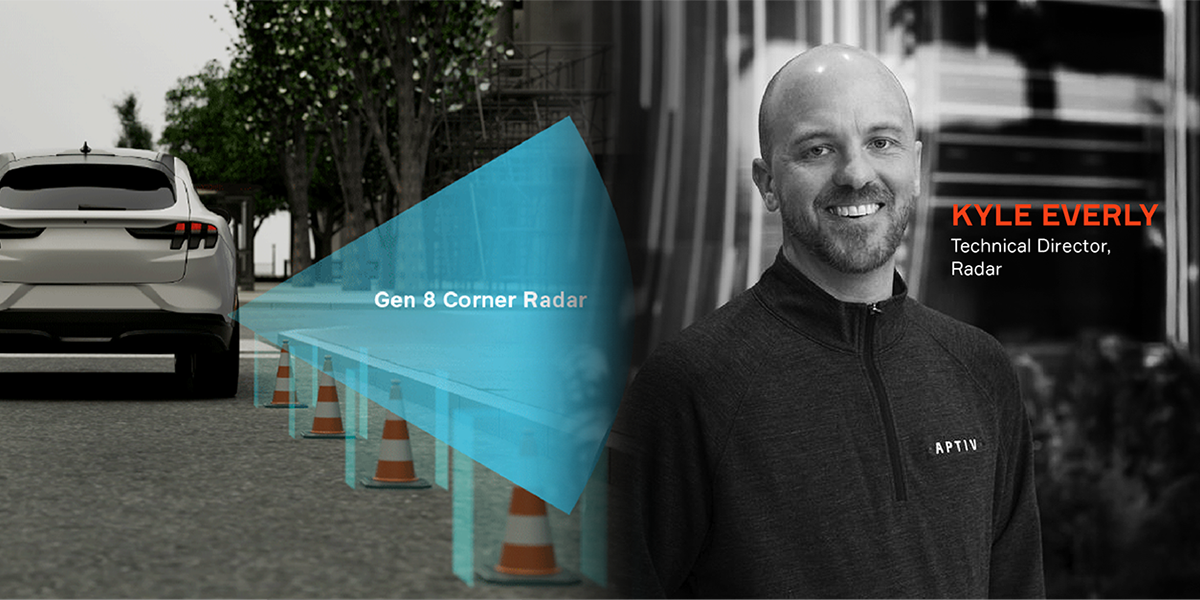Q&A: Key Technologies in Aptiv’s Gen 8 Radars
Aptiv’s latest radars boast significant technological advancements. The Gen 8 radars enhance performance, expand ADAS features, offer regulatory readiness and enhance cost efficiency —which sets them apart from previous generations and competing solutions. We sat down with Kyle Everly, Aptiv’s director of technical program management for radar perception, to find out more about the technologies that make Gen 8 one of the most compelling milestones in Aptiv’s quarter century of experience in automotive radar systems.
What are the key improvements in the Gen 8 radars?
Gen 8 radars combine proprietary hardware and software to deliver improvements in a number of areas. Two especially stand out.
First, we have upgraded RF [radio frequency] performance, which enhances range and coverage. For example, the FLR8 can support detection beyond 300 meters. The SRR8+ maintains Aptiv’s industry-leading range in the corner radar space, but it does that over a significantly larger vertical field of view compared with prior generations.
Second, we’ve improved horizontal- and vertical-angle performance by 25 percent over the previous generation. Both the FLR8 and SRR8+ are 4D radars, so they add the vertical dimension, which means they can separate object detection by vertical angle in addition to the horizontal angle. Importantly, they use a single transceiver. Such performance had previously been achievable only by cascading RFICs [radio-frequency integrated circuits], a design that is more expensive both in terms of power consumption and, ultimately, cost.
What do these improvements enable that couldn’t be done before?
Gen 8 radars will take current Gen 7 radar features and make them more robust and reliable, in addition to enabling them in more scenarios. They will unlock new ADAS capabilities as well. For example, we can offer automated parking beyond just controlled environments.
For features that already exist, such as determining the over- or under-drivability of objects in the road, the operational design domain is expanded, so features like automated emergency braking can be applied in more scenarios.
The high performance of the radars unlocks new possibilities in hands-free driving, which can now be performed in dense and complex environments, such as city streets and parking structures. The quality of the sensor data also improves features like scene perception and enables real-time drivable-space estimation.
We’ve doubled the number of channels. What does that mean for perception and, consequently, safety?
We’ve doubled the number of received channels, effectively doubling the amount of data available to perceive what is happening in the environment. That increase in data allows us to improve the speed and accuracy of object detection and classification, giving human drivers and ADAS more time to react in critical situations.
In terms of functional safety specifically, the radars will support an ASIL-B classification, including ASIL-B(D) in an ASIL-D system. Beyond that, Gen 8 radars will support future new car assessment programs and enable compliance with some of the upcoming regulatory requirements, such as FMVSS 127, by providing denser, richer and higher-quality perception data to the ADAS. With radar technology, we will achieve improvements regardless of lighting conditions, which means we can do that at night, in the dark, which is also an important test condition for FMVSS 127.
How do Gen 8 radars handle interference challenges, especially in dense and complex urban environments?
We’ve introduced new waveform techniques and countermeasures to better enable the separation of desired signals from interferer signals, which also helps with reflected signals. The custom processor in Gen 8 contains algorithms that not only detect and remove interference but also restore signals that have been corrupted by interference. This improved, restorative approach avoids signal-processing artifacts and maintains the dynamic range and detection capability, which improves the overall robustness of the radar in environments with many radars sharing the same frequency band.
How do Gen 8 radars handle detection of pedestrians and cyclists, especially in corner cases?
The 4D and fine-angle resolution of Gen 8 radars enhances object detection and classification, even for low signal-to-noise ratio [SNR] targets and in environments that require high dynamic range. This improvement enables the detection, separation and tracking of targets that were missed in prior generations of radar, allowing for better detection of vulnerable road users, especially in challenging scenarios, such as a pedestrian standing next to a parked car or another highly reflective object.
Could you explain dynamic range and its effect on resolution?
Dynamic range refers to the full span of changing conditions. If we have better dynamic range, we’re able to detect a small target in the presence of a large target. “Small” and “large” here don’t necessarily mean physical size; they mean reflectivity or signal-to-noise ratio. For example, while a driver can see that a pedestrian is standing near a truck, with radar the pedestrian may be “masked” by the truck or, in essence, lost in the shadow. Without excellent dynamic range, the radar can’t pick the pedestrian out of the data.
One of the cases where this comes into play is if you have two targets at the same range and moving with the same speed, but one is low SNR and the other high SNR. In those situations, which often occur in urban and parking scenarios, previous radars would struggle to pick up the low-SNR target. Improved dynamic range helps us to identify both of those targets, which expands the availability of features, including pedestrian AEB [automatic emergency braking] and automated parking.
A significant part of the value that we bring is in the signal processing of that data and knowing how to extract the most out of a given antenna.
